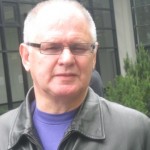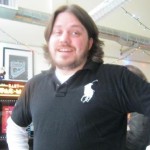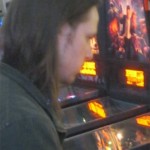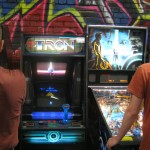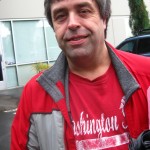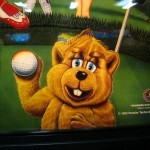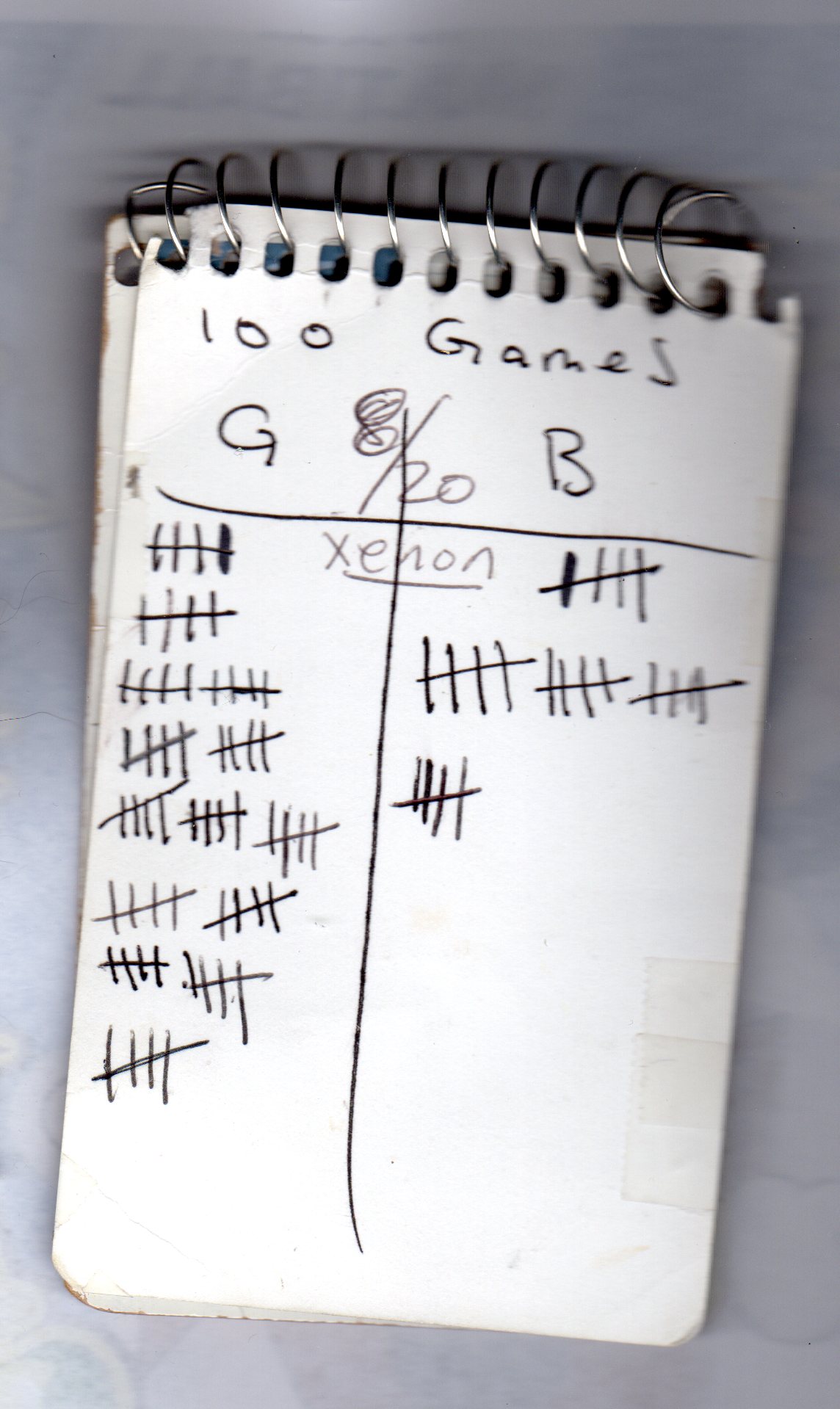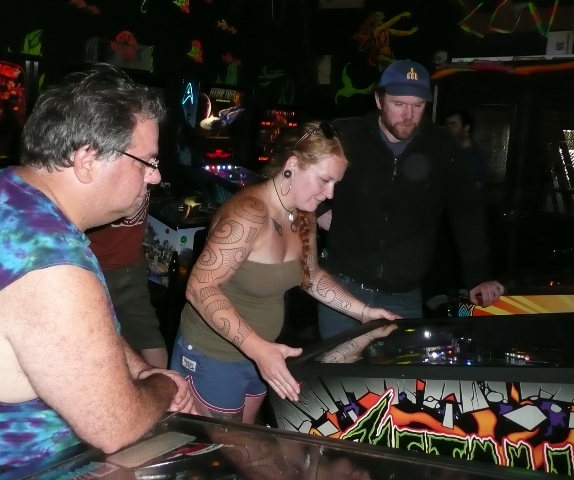The Ballard Pinball Tournament had the unusual starting time of  3 in the afternoon on Monday May 30th, because it was Memorial Day. As always the Ballard Tournament is a roving event that moves to different establishments in the neighborhood, but because of the holiday many of the planned venues were either closed or had inconvenient hours. Claire and Headley’s Pinball Room was also out of the running because of a new floor being installed, so all the matches were held at Snoose Junction and Liberty House. Julie Gray took first place and Graham Klym took second. Liberty House was a great place to go because they had hosted the Sam Theoharis Memorial Croquet Tournament the day before and were still stocked with grills, beer and pinball machines. Pinball Summer!
3 in the afternoon on Monday May 30th, because it was Memorial Day. As always the Ballard Tournament is a roving event that moves to different establishments in the neighborhood, but because of the holiday many of the planned venues were either closed or had inconvenient hours. Claire and Headley’s Pinball Room was also out of the running because of a new floor being installed, so all the matches were held at Snoose Junction and Liberty House. Julie Gray took first place and Graham Klym took second. Liberty House was a great place to go because they had hosted the Sam Theoharis Memorial Croquet Tournament the day before and were still stocked with grills, beer and pinball machines. Pinball Summer!
Another reason Headley’s pins were not available was because they 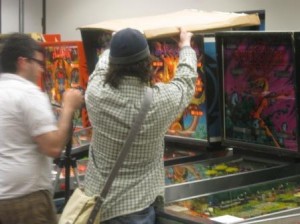 were being packed up for the Pacific Northwest Pinball and Gameroom Show (PAGS) later in the week. This annual event is something we look forward to each summer and Skill Shot was graciously allowed to take pictures of the games while they were being set up on Thursday evening. A lot of love and work goes into this show and we were impressed with how it was set up this year. Look for our full report on PAGS elsewhere in this issue!
were being packed up for the Pacific Northwest Pinball and Gameroom Show (PAGS) later in the week. This annual event is something we look forward to each summer and Skill Shot was graciously allowed to take pictures of the games while they were being set up on Thursday evening. A lot of love and work goes into this show and we were impressed with how it was set up this year. Look for our full report on PAGS elsewhere in this issue!
As usual, there have been a lot of local tournaments happening, and on June 9th the Seattle Pinball Museum held the first in their new quarterly format. Hosted by Jeff Groper, the tournament had 40 contestants as well as many observers, including British pinball author Gary Flowers and Canadian Bally repair expert Lindsey Rupertus. Steve Ackley took the top prize and Brian Headley took second. Later that evening we had a 5 game tournament of our own at Shorty’s against Sergey and Heather. Using our 100 Pinball Game Equation (from issue 16) we luckily didn’t bet any money because Heather won. It’s more fun to compete!
As if that wasn’t enough pinball tournament action for a week, the next night (6/10) was the first of three official TRON Pinball Release Parties! The TRON events also featured a tournament and the first one at the Seattle Waterfront Arcade was won by Maka. The next day (6/11) had a TRON party at Flynn’s Arcade in Tacoma (a.k.a. Dorky’s), and the pinball machine was hooked up to the sound system for the final match, which ELF won. Four days later (6/14) at the Seattle Pinball Museum, TRON had another release party that was won by Seattle Pinball League treasurer Hannah Olson. And we missed them all!
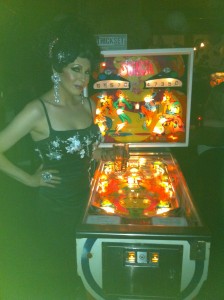
Other pinball events we missed include the annual Summer Solstice Soiree at Andrew Nunes’ house that happened on the same day as the Fremont Solstice Day Parade; the July Seattle Pinball League Tournament that was held at Mike Lorrain’s home, won by Randy Pouley; the first tournament at Bridle Trails New York Pizza in Kirkland, won by Beth Johns; and the Super Multi-Brawl tournament in Vancouver BC, won by Cayle. A Vancouver tournament is apparently a rare event because most pins are in private homes rather than on location. They haven’t had a public tournament in years. Sorry, Maka.
Rod Olson’s annual 4th of July Party was a great time as always. 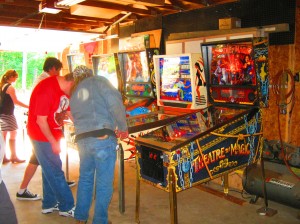 The festivities included tasty food, fireworks, tank battles and of course, lots of pinball. Rod has a great collection of pins and this year he also had a nice set up in his garage. Some of the games included Fish Tales, two NBA Fastbreak that were connected to each other and 300, which became the center of attention when we held a Biggest Loser Tournament, won by Rod’s stepmother. Those Olsons have pinball in their blood!
The festivities included tasty food, fireworks, tank battles and of course, lots of pinball. Rod has a great collection of pins and this year he also had a nice set up in his garage. Some of the games included Fish Tales, two NBA Fastbreak that were connected to each other and 300, which became the center of attention when we held a Biggest Loser Tournament, won by Rod’s stepmother. Those Olsons have pinball in their blood!
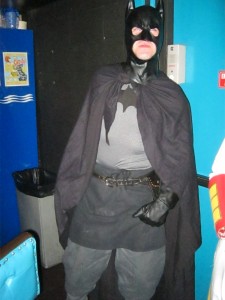 Birthdays seem to be popular times to have pinball tournaments at Shorty’s. 4th Place Andy hosted The Trick Pinball Olympics on June 21st. Four different pins had different games: Biggest Loser on Speakeasy; Pat Hand on The Addams Family; Blind Folded (Tommy) on Family Guy; and Half and Half on Champion Pub. The highest scores were awarded points with the four highest scorers moving on to the final match on TRON, which Pancakes easily won. Jawn Wakefield had a Batman-themed
Birthdays seem to be popular times to have pinball tournaments at Shorty’s. 4th Place Andy hosted The Trick Pinball Olympics on June 21st. Four different pins had different games: Biggest Loser on Speakeasy; Pat Hand on The Addams Family; Blind Folded (Tommy) on Family Guy; and Half and Half on Champion Pub. The highest scores were awarded points with the four highest scorers moving on to the final match on TRON, which Pancakes easily won. Jawn Wakefield had a Batman-themed 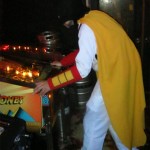 birthday on July 21st, with a Bat-Hand tournament on Batman, naturally. In this tournament, players had to use the opposite hand for each flipper and you could do either forwards (like most people did) or backwards, which seemed to help some folks. This style of playing is fun and challenging and we would like to see it played again sometime on an easier game. Bat Fun!
birthday on July 21st, with a Bat-Hand tournament on Batman, naturally. In this tournament, players had to use the opposite hand for each flipper and you could do either forwards (like most people did) or backwards, which seemed to help some folks. This style of playing is fun and challenging and we would like to see it played again sometime on an easier game. Bat Fun!
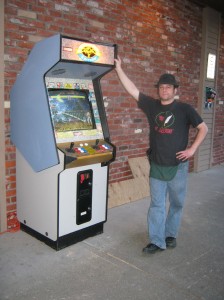 We made it to Dorky’s recently and were impressed with their large game selection. It’s like a mini PAGS with a ton of arcade games and over 20 pinball machines, many of which you don’t often see available to the public. Dirty Harry, Data East’s Star Trek and Indianapolis 500 are just a few of the older games there, as well as newer pins like Big Buck Hunter and TRON. There were a few bands playing in the big room the night we visited and we watched Les the owner moving games around so a stage could be built. Later he even had a working arcade game out on the sidewalk for people to play. Dorky’s is in a nice part of Tacoma and there’s a lot of different neat bars and other businesses within walking distance. You don’t have to go anywhere else to get a drink though, because beginning August 1st Dorky’s started selling beer. Beer!
We made it to Dorky’s recently and were impressed with their large game selection. It’s like a mini PAGS with a ton of arcade games and over 20 pinball machines, many of which you don’t often see available to the public. Dirty Harry, Data East’s Star Trek and Indianapolis 500 are just a few of the older games there, as well as newer pins like Big Buck Hunter and TRON. There were a few bands playing in the big room the night we visited and we watched Les the owner moving games around so a stage could be built. Later he even had a working arcade game out on the sidewalk for people to play. Dorky’s is in a nice part of Tacoma and there’s a lot of different neat bars and other businesses within walking distance. You don’t have to go anywhere else to get a drink though, because beginning August 1st Dorky’s started selling beer. Beer!
Another business that recently got a license to sell beer and wine is the Seattle Pinball Museum! With their ever-changing collection of games and plans to open The Upper Playfield soon, the SPM just keeps getting better and better. Owner Charlie Martin wanted us to mention that if you need a pinball machine fixed in your home, the SPM might be able to help and Cindy Martin reminded us that they are now selling Full Tilt Ice Cream. Speaking of Full Tilt, we heard that the building permits for their future Ballard business have finally arrived. The new location will have more pinball than either of their other two arcades and will most likely be open in 6 to 8 weeks. Sweet.
The Pinball and Arcade Swap Meet happened in the parking lot of  Specialty Coin in Kent and despite the rain there was a good turnout. There was lots of different stuff for sale or trade, including a No Good Gofers pinball machine and various ramps, switches and
Specialty Coin in Kent and despite the rain there was a good turnout. There was lots of different stuff for sale or trade, including a No Good Gofers pinball machine and various ramps, switches and 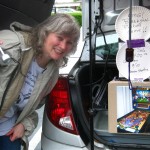 instruction manuals for many different games. Specialty Coin was also open and had Rolling Stones and NASCAR pins to play. Chris Walsh and Butch Clifford brought a generator along with Radical and Strike and Spares in the back of their truck, so those pins were also available to play. There’s talk of starting another swap meet on the north-end, but organizer Keith Nelson would rather have someone else coordinate that one. Thrifty!
instruction manuals for many different games. Specialty Coin was also open and had Rolling Stones and NASCAR pins to play. Chris Walsh and Butch Clifford brought a generator along with Radical and Strike and Spares in the back of their truck, so those pins were also available to play. There’s talk of starting another swap meet on the north-end, but organizer Keith Nelson would rather have someone else coordinate that one. Thrifty!
 Last issue’s Skill Shot Folding Party at The Lookout was our most successful one yet; over 1600 issues of the zine were folded in record time and we would like to thank everyone who stopped by to help out. Also, thanks again to The Lookout who provided us with tasty sliders and hummus (and beer). Have you been to our
Last issue’s Skill Shot Folding Party at The Lookout was our most successful one yet; over 1600 issues of the zine were folded in record time and we would like to thank everyone who stopped by to help out. Also, thanks again to The Lookout who provided us with tasty sliders and hummus (and beer). Have you been to our  website? www.skill-shot.com is the place to go for all past Skill Shot articles and covers. There’s also current news and gossip tidbits, updated calendar listings and more, so check it out. You can also see what the current The One To Beat score is. We had to change the pin because no one could beat MAK’s 1,136,165,620 on Batman at Shorty’s. We’re sure everyone wants another chance to beat Maka so the new TOTB is the Jack-Bot at the Rabbit Hole in Belltown. Go Team Skill Shot!
website? www.skill-shot.com is the place to go for all past Skill Shot articles and covers. There’s also current news and gossip tidbits, updated calendar listings and more, so check it out. You can also see what the current The One To Beat score is. We had to change the pin because no one could beat MAK’s 1,136,165,620 on Batman at Shorty’s. We’re sure everyone wants another chance to beat Maka so the new TOTB is the Jack-Bot at the Rabbit Hole in Belltown. Go Team Skill Shot!
Pinball Tidbits: The WWF Royal Rumble at the 9LB Hammer has a DMD that randomly goes out multiple times during a game. The Randy Savage sound bites made this a fitting place to have a drink  when remembering The Macho Man • The Lookout has finally replaced the no tilt Frankenstein with Pirates of the Caribbean, and it plays pretty well if you’re not Jeff Groper • Pinball champ Nycole Hyatt is now bartending at the Tiger Lounge and plans are forming for a
when remembering The Macho Man • The Lookout has finally replaced the no tilt Frankenstein with Pirates of the Caribbean, and it plays pretty well if you’re not Jeff Groper • Pinball champ Nycole Hyatt is now bartending at the Tiger Lounge and plans are forming for a 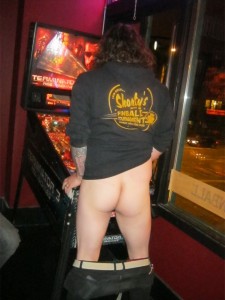 tournament there • The Fun House finally has a Fun House • The current season of Hell’s Kitchen has a pinball-themed intro that you should check out (on FOX) • The Highline took out part of the bar and built a pinball cove • The next new Stern will be Transformers • The Annual Shorty’s Pinball Tournament has changed dates to November 5 &6 • We want to go Pinball Camping!
tournament there • The Fun House finally has a Fun House • The current season of Hell’s Kitchen has a pinball-themed intro that you should check out (on FOX) • The Highline took out part of the bar and built a pinball cove • The next new Stern will be Transformers • The Annual Shorty’s Pinball Tournament has changed dates to November 5 &6 • We want to go Pinball Camping!
SUPPORT LOCAL PINBALL

